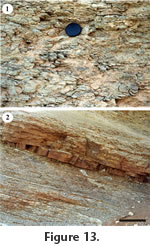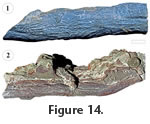|
|
|
DISCUSSION: PALEOGEOGRAPHIC DIACHRONEITY OF INFAUNALIZATIONThe Ordovician was characterized by the most extensive global radiation (at species to order level) in the history of the biosphere (Miller 2004). Our knowledge of this radiation has increased by looking at the diversity trajectories of different taxa (see papers in Webby et al. 2004). Very few studies, however, have explored the potential of trace fossils to yield insights into the Ordovician radiation (e.g., Mángano and Droser 2004). Our data from upper-offshore facies in northwest Argentina indicate that the early to late Tremadocian interval represents a critical time, during which exploitation of infaunal ecospace increased, resulting in the establishment of a mid-tier benthos represented by Trichophycus venosus (Figure 12). As a result, the preservation potential of shallow tiers was significantly reduced, and shallowly emplaced trilobite-produced trace fossils (often showing conspicuous scratch marks) became less common in fully marine settings by the end of the period. The pristine preservation of thin tempestites in Cambrian to Lower Ordovician shallow-marine deposits most likely reflects the restriction of the benthic fauna to the uppermost zones of the sediment and the absence of true sediment bulldozers (Mángano et al. 2005a).
The ichnogenus Trichophycus is also present in the peri-Gondwanic microcontinent Avalonia. It has been documented in Arenigian siliciclastic marine deposits of the Wabana Group in Newfoundland (Fillion and Pickerill 1990; Droser et al. 2004) (Figure 14.1). In contrast to the examples from northwest Argentina, specimens from the Lower Ordovician Grebes Nest Point Formation of Newfoundland seem to have occupied a shallow-tier position (Droser et al. 2004). Interestingly, Trichophycus is not known from the older Upper Cambrian-Tremadocian deposits of Newfoundland, which have been studied intensely (Fillion and Pickerill 1990). Trichophycus is also present in Caradocian marine deposits of Wales (Pickerill 1977). The information available from Newfoundland and Wales is consistent with the timing of the first appearance of Trichophycus in various regions of Gondwana.
Other trace fossils, such as arthrophycids and teichichnids, are somewhat similar to Trichophycus in terms of overall morphology and in some cases functional significance. Although evaluation of evolutionary trends displayed by these trace fossils in the various paleocontinents requires more extensive datasets, some patterns seem to be apparent. Three ichnogenera, Daedalus, Arthrophycus and Phycodes, are included in Arthrophycidae (Seilacher 2000). This ichnofamily is characterized by fine morphologic details, in particular unique transversal annulations (Seilacher 2000), and is essentially a product of the Ordovician radiation, although some of its most simple representatives are known since the Cambrian (Mángano et al. 2005b). Daedalus occupies a deep-tier position, reaching depths of up to 90 cm (Seilacher 2000). It is restricted to relatively high-energy clean sandstones, and ranges in age from Arenigian to Early Silurian, displaying more precise biostratigraphic significance at ichnospecies level (Seilacher 2000). Arthrophycus is mostly a mid-tier form, particularly in the case of Lower Silurian ichnospecies, such as A. alleghaniensis and A. lateralis. The Lower Ordovician to Lower Silurian A. brongniartii (=A. linearis) occupies shallow tiers. The oldest representative, the Late Cambrian to Early Ordovician A. minimus, is a very shallow-tier form that occurs in upper-offshore deposits of the Alfarcito Member in northwest Argentina (Mángano et al. 2005b). The tiering position of Phycodes also varies at ichnospecies level. The earliest representative is Phycodes palmatus, which is known since the Early Cambrian (Crimes and Anderson 1985; Narbonne et al. 1987; Jensen 1997) and is typically a very shallow-tier ichnospecies. Tremadocian to Lower Arenigian ichnospecies, such as P. ungulatus and P. wabanensis (Fillion and Pickerill 1990), seem to have occupied a shallow tier. In contrast, some of the later forms (the uppermost Arenigian P. fusiforme, the upper Arenigian-lower Llanvirnian P. parallelum, and the Caradocian-Ashgillian P. flabellum) are mid-tier forms (Seilacher 2000). Phycodes circinatus, also a shallow-tier form, typically occurs in Lower Ordovician rocks in Gondwana, but may extend to those of Middle Ordovician age in Laurentia (Fillion and Pickerill 1990). Seilacher (2000) noted that the arthrophycid nature of Phycodes is less well founded. This doubt is especially true of the earliest representatives in which the diagnostic fingerprints of the family (i.e., arthrophycid corrugations) are not present. In general Arthrophycus and Phycodes show a tendency to occupy slightly deeper tiers through the Ordovician and, in the case of the former, into the Silurian. Although the ichnogenera Syringomorpha and Helichone have been referred to as teichichnids by Seilacher (2007), Teichichnus itself is the most representative element of this group and that most similar to Trichophycus. However, the ichnotaxonomy of Teichichnus is in need of revision, and potential evolutionary trends remain unidentified. Teichichnus rectus is the most common ichnospecies. It is a facies-crossing form, typically occupying shallow to mid tiers, which is common not only in fully marine settings but also in brackish-water environments since the Cambrian (Buatois et al. 2005). Lower Paleozoic examples of T. rectus are commonly shallower tier than younger specimens (e.g. Buckman 1996). Teichichnus stellatus is a shallow-tier form that occurs in Arenigian offshore to shelf deposits of northern Spain (Baldwin 1977). However, its radial morphology suggests that this ichnospecies may be removed from Teichichnus and placed in some of the many ichnogenera available for rosette trace fossils. Notably, in its type locality T. stellatus occurs in the same interval than radial ichnofossils referred to as Volkichnium ?volki by Baldwin (1977), opening the possibility that T. stellatus is a preservational variant of the latter. Alternatively, re-examination of the lower Paleozoic outcrops of northern Spain suggests that the radial morphology may have resulted from the intersection of several specimens of T. rectus (García Ramos, personal commun., 2009). Other ichnospecies of Teichichnus (e.g., T. spiralis, T zigzag, T. sigmoidalis) are post-Paleozoic and may occupy mid to relatively deep tiers (Frey and Bromley 1985; Buatois et al. 2003b; Seilacher 2007; Carmona et al. 2008). The need to identify ecologic differences among Ordovician faunas at local, regional, and inter-continental scales has been advocated by Miller (2004). Studies on different fossil groups have helped to reveal whether global diversity trajectories resemble those at local and regional scales. The emerging view is that both the timing of diversification and the accompanying ecologic changes were diachronous across the different environments and paleocontinents (Webby et al. 2004; Harper 2006). For example, diversification of some brachiopod groups (e.g., plectambonitoids) was delayed in Gondwana with respect to Baltica (Harper et al. 2004). The opposite trend, however, was proposed for bivalves, which seem to have radiated first in Gondwana and later migrated to lower latitudes (Cope and Babin 1999; Sánchez and Babin 2003; Cope 2004; Sánchez 2008). Studies of trilobite and brachiopod faunas from the Argentinean basins have noted a slight decoupling between diversification events in this region and those at global scale (Waisfeld et al. 1999, 2003). These studies emphasize the need to consider how geodynamic histories and paleogeography play a role in shaping diversity trajectories. Some of these trajectories may be linked to latitudinal differences. Some of the areas of Gondwana discussed herein (Argentina and Morocco) occupied high to intermediate latitudes during the early Paleozoic, while Laurentia was located at low latitudes. However, although Cambrian paleomagnetic data for Baltica are controversial, a position at mid latitudes is the most likely (Smith 2001). This pattern indicates a more complex paleogeographic pattern of infaunalization and suggests that factors other than latitude may have played a role in the diachronic trajectories of ecologic innovation across the different paleocontinents. Our study underscores the importance of expanding the database of Cambrian-Ordovician ichnofaunas to account for ecologic differences among regions. |
|

